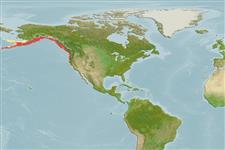Bivalvia |
Pectinida |
Pectinidae
Environment: milieu / climate zone / गहराई सीमा / distribution range
पारिस्थितिकी
; गहराई सीमा 2 - 300 m (संदर्भ 114301), usually 60 - 120 m (संदर्भ 114306). Temperate, preferred 7°C (संदर्भ 107945); 64°N - 36°N, 179°W - 120°W
Eastern Pacific: From Pribilof Islands, Alaska to Point Sur, California, USA. Temperate to boreal.
Length at first maturity / आकार / Weight / Age
परिपक्व अवधि: Lm ? range ? - ? cm Max length : 28.0 cm SHL पुल्लिंग / अलिंग; (संदर्भ 95344); अधिकतम सूचित उम्र: 15 वर्षो (संदर्भ 8702)
Found in small depressions on sandy-gravely substrates (Ref. 95344).
Life cycle and mating behavior
परिपक्व अवधि | पुनरुत्पत्ति | मछलीऔ का अंडे देना | Eggs | Fecundity | Larvae
Members of the class Bivalvia are mostly gonochoric, some are protandric hermaphrodites. Life cycle: Embryos develop into free-swimming trocophore larvae, succeeded by the bivalve veliger, resembling a miniature clam.
Ignell, S. and E. Haynes 2000 Geographic patterns in growth of the giant Pacific sea scallop, Patinopecten caurinus. Fish. Bull. 98:849-853. (संदर्भ 386)
IUCN Red List Status
(संदर्भ 130435: Version 2025-1)
CITES status (संदर्भ 108899)
Not Evaluated
CMS (संदर्भ 116361)
Not Evaluated
Threat to humans
Human uses
मात्स्यिकी: व्यापारिक
FAO - मात्स्यिकी: landings | FishSource | Sea Around Us
साधन
अधिक जानकारी
Life cycleपुनरुत्पत्तिपरिपक्व अवधिFecundityमछलीऔ का अंडे देनाEggsEgg developmentLarvae PhysiologyOxygen consumption
Human RelatedStamps, coins, misc.
इंटरनेट स्रोत
Estimates based on models
Preferred temperature
(Ref.
115969): 0.7 - 9.6, mean 5.1 (based on 348 cells).
लौटाव
ऊंचा, न्यूनतम जनसंख्या दुगनी समय अवलागत 15 महीने। (K=0.39-0.5; tmax=15).
Fishing Vulnerability
Moderate vulnerability (40 of 100).
Climate Vulnerability
High to very high vulnerability (75 of 100).
Nutrients : Calcium = 149 [71, 228] mg/100g; Iron = 8.53 [1.95, 15.11] mg/100g; Protein = 9.88 [8.64, 11.12] %; Omega3 = 0.313 [0.202, 0.423] g/100g; Selenium = 61 [50, 72] μg/100g; VitaminA = 0 μg/100g; Zinc = 2.04 [0.56, 3.51] mg/100g (wet weight); based on
nutrient studies.
